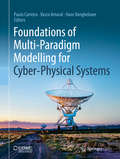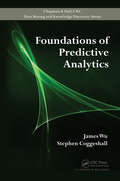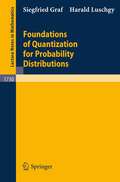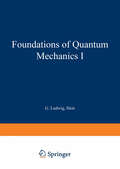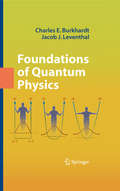- Table View
- List View
Foundations of Microsoft Expression Web: The Basics and Beyond
by Cheryl D. WiseMicrosoft's Expression Suite promises new levels of power in creating rich dynamic user experiences on the web, and Expression Web Designer is but one program within that suite. This is one of the first books available on the subject. The author starts with the very basics, and then takes the reader up to advanced level through a series of practical real world exercises. Although no knowledge is assumed, the book is carefully written to not be patronizing, and be of use to more advanced web developers and designers wishing to make use of the software, as well as complete beginners.
Foundations of Mobile Media Studies: Essential Texts on the Formation of a Field (Routledge Recommends)
by Jason FarmanFoundations of Mobile Media Studies gathers some of the most important texts in this emerging field, offering readers key approaches to understanding our moment and our media. The impact of mobile media is far reaching and this book discusses topics such as human intimacy, social space, political uprisings, labor, mobile phones in the developing world, gender, the mobile device’s impact on reading, mobile television, and mobile photography, among others. This carefully curated collection will serve as the central text to introduce this field to anyone eager to understand the rise of mobile technology, its impact on our relationships, and how these media have transformed the ways we understand the world around us.
Foundations of Mobile Media Studies: Essential Texts on the Formation of a Field (Routledge Recommends)
by Jason FarmanFoundations of Mobile Media Studies gathers some of the most important texts in this emerging field, offering readers key approaches to understanding our moment and our media. The impact of mobile media is far reaching and this book discusses topics such as human intimacy, social space, political uprisings, labor, mobile phones in the developing world, gender, the mobile device’s impact on reading, mobile television, and mobile photography, among others. This carefully curated collection will serve as the central text to introduce this field to anyone eager to understand the rise of mobile technology, its impact on our relationships, and how these media have transformed the ways we understand the world around us.
Foundations of Multi-Paradigm Modelling for Cyber-Physical Systems
This open access book coherently gathers well-founded information on the fundamentals of and formalisms for modelling cyber-physical systems (CPS). Highlighting the cross-disciplinary nature of CPS modelling, it also serves as a bridge for anyone entering CPS from related areas of computer science or engineering.Truly complex, engineered systems—known as cyber-physical systems—that integrate physical, software, and network aspects are now on the rise. However, there is no unifying theory nor systematic design methods, techniques or tools for these systems. Individual (mechanical, electrical, network or software) engineering disciplines only offer partial solutions. A technique known as Multi-Paradigm Modelling has recently emerged suggesting to model every part and aspect of a system explicitly, at the most appropriate level(s) of abstraction, using the most appropriate modelling formalism(s), and then weaving the results together to form a representation of the system. If properly applied, it enables, among other global aspects, performance analysis, exhaustive simulation, and verification. This book is the first systematic attempt to bring together these formalisms for anyone starting in the field of CPS who seeks solid modelling foundations and a comprehensive introduction to the distinct existing techniques that are multi-paradigmatic. Though chiefly intended for master and post-graduate level students in computer science and engineering, it can also be used as a reference text for practitioners.
Foundations of Object-Oriented Programming Using .NET 2.0 Patterns
by Christian Gross* Includes coverage on .NET Generics, .NET 2.0. and coverage of both Open Source and Closed Source libraries and applications. *Based on C# code examples that work on multiple platforms (e.g. Linux, Windows, etc). * Focuses on solving problems in short and easy to digest segments.
Foundations of Physically Based Modeling and Animation
by Donald House John C. KeyserPhysics forms the basis for many of the motions and behaviors seen in both the real world and in the virtual worlds of animated films, visual effects, and computer games. By describing the underlying physical principles and then creating simulations based on these principles, these computer-generated worlds are brought to life. Physically Based Modeling and Animation goes behind the scenes of computer animation and details the mathematical and algorithmic foundations that are used to determine the behavior underlying the movement of virtual objects and materials. Dr. Donald House and Dr. John Keyser offer an approachable, hands-on view of the equations and programming that form the foundations of this field. They guide readers from the beginnings of modeling and simulation to more advanced techniques, enabling them to master what they need to know in order to understand and create their own animations Emphasizes the underlying concepts of the field, and is not tied to any particular software package, language, or API. Develops concepts in mathematics, physics, numerical methods, and software design in a highly integrated way, enhancing both motivation and understanding. Progressively develops the material over the book, starting from very basic techniques, and building on these to introduce topics of increasing complexity. Motivates the topics by tying the underlying physical and mathematical techniques directly to applications in computer animation.
Foundations of Physically Based Modeling and Animation
by John C. Keyser Donald HousePhysics forms the basis for many of the motions and behaviors seen in both the real world and in the virtual worlds of animated films, visual effects, and computer games. By describing the underlying physical principles and then creating simulations based on these principles, these computer-generated worlds are brought to life. Physically Based Modeling and Animation goes behind the scenes of computer animation and details the mathematical and algorithmic foundations that are used to determine the behavior underlying the movement of virtual objects and materials. Dr. Donald House and Dr. John Keyser offer an approachable, hands-on view of the equations and programming that form the foundations of this field. They guide readers from the beginnings of modeling and simulation to more advanced techniques, enabling them to master what they need to know in order to understand and create their own animations Emphasizes the underlying concepts of the field, and is not tied to any particular software package, language, or API. Develops concepts in mathematics, physics, numerical methods, and software design in a highly integrated way, enhancing both motivation and understanding. Progressively develops the material over the book, starting from very basic techniques, and building on these to introduce topics of increasing complexity. Motivates the topics by tying the underlying physical and mathematical techniques directly to applications in computer animation.
Foundations of Popfly: Rapid Mashup Development
by Eric GriffinPopfly was created as a tool for designers to build mashups in a visual manner, rapidly, without needing to know any code. By simply dragging out "blocks" that represent services such as Flickr onto your workspace and then drawing connection lines between them, you can create a mashup. It’s as easy as that! Get Popfly and Silverlight up and running on your computer, and then learn how to use the Popfly Mashup Creator and Popfly Web Page Creator to share your mashups with the world. Author Eric Griffin will introduce you to Popfly and show you everything you need to start creating your own hybrid web applications.
Foundations of Predictive Analytics
by James Wu Stephen CoggeshallDrawing on the authors' two decades of experience in applied modeling and data mining, Foundations of Predictive Analytics presents the fundamental background required for analyzing data and building models for many practical applications, such as consumer behavior modeling, risk and marketing analytics, and other areas. It also discusses a variety
Foundations of Probabilistic Logic Programming: Languages, Semantics, Inference and Learning
by Fabrizio RiguzziProbabilistic Logic Programming extends Logic Programming by enabling the representation of uncertain information by means of probability theory. Probabilistic Logic Programming is at the intersection of two wider research fields: the integration of logic and probability and Probabilistic Programming.Logic enables the representation of complex relations among entities while probability theory is useful for model uncertainty over attributes and relations. Combining the two is a very active field of study.Probabilistic Programming extends programming languages with probabilistic primitives that can be used to write complex probabilistic models. Algorithms for the inference and learning tasks are then provided automatically by the system.Probabilistic Logic programming is at the same time a logic language, with its knowledge representation capabilities, and a Turing complete language, with its computation capabilities, thus providing the best of both worlds.Since its birth, the field of Probabilistic Logic Programming has seen a steady increase of activity, with many proposals for languages and algorithms for inference and learning. Foundations of Probabilistic Logic Programming aims at providing an overview of the field with a special emphasis on languages under the Distribution Semantics, one of the most influential approaches. The book presents the main ideas for semantics, inference, and learning and highlights connections between the methods.Many examples of the book include a link to a page of the web application http://cplint.eu where the code can be run online.
Foundations of Probabilistic Logic Programming: Languages, Semantics, Inference and Learning (River Publishers Series In Software Engineering Ser.)
by Fabrizio RiguzziProbabilistic Logic Programming extends Logic Programming by enabling the representation of uncertain information by means of probability theory. Probabilistic Logic Programming is at the intersection of two wider research fields: the integration of logic and probability and Probabilistic Programming.Logic enables the representation of complex relations among entities while probability theory is useful for model uncertainty over attributes and relations. Combining the two is a very active field of study.Probabilistic Programming extends programming languages with probabilistic primitives that can be used to write complex probabilistic models. Algorithms for the inference and learning tasks are then provided automatically by the system.Probabilistic Logic programming is at the same time a logic language, with its knowledge representation capabilities, and a Turing complete language, with its computation capabilities, thus providing the best of both worlds.Since its birth, the field of Probabilistic Logic Programming has seen a steady increase of activity, with many proposals for languages and algorithms for inference and learning. Foundations of Probabilistic Logic Programming aims at providing an overview of the field with a special emphasis on languages under the Distribution Semantics, one of the most influential approaches. The book presents the main ideas for semantics, inference, and learning and highlights connections between the methods.Many examples of the book include a link to a page of the web application http://cplint.eu where the code can be run online.
Foundations of Probabilistic Logic Programming: Languages, Semantics, Inference and Learning
by Fabrizio RiguzziSince its birth, the field of Probabilistic Logic Programming has seen a steady increase of activity, with many proposals for languages and algorithms for inference and learning. This book aims at providing an overview of the field with a special emphasis on languages under the Distribution Semantics, one of the most influential approaches. The book presents the main ideas for semantics, inference, and learning and highlights connections between the methods. Many examples of the book include a link to a page of the web application http://cplint.eu where the code can be run online. This 2nd edition aims at reporting the most exciting novelties in the field since the publication of the 1st edition. The semantics for hybrid programs with function symbols was placed on a sound footing. Probabilistic Answer Set Programming gained a lot of interest together with the studies on the complexity of inference. Algorithms for solving the MPE and MAP tasks are now available. Inference for hybrid programs has changed dramatically with the introduction of Weighted Model Integration. With respect to learning, the first approaches for neuro-symbolic integration have appeared together with algorithms for learning the structure for hybrid programs. Moreover, given the cost of learning PLPs, various works proposed language restrictions to speed up learning and improve its scaling.
Foundations of Probabilistic Logic Programming: Languages, Semantics, Inference and Learning
by Fabrizio RiguzziSince its birth, the field of Probabilistic Logic Programming has seen a steady increase of activity, with many proposals for languages and algorithms for inference and learning. This book aims at providing an overview of the field with a special emphasis on languages under the Distribution Semantics, one of the most influential approaches. The book presents the main ideas for semantics, inference, and learning and highlights connections between the methods. Many examples of the book include a link to a page of the web application http://cplint.eu where the code can be run online. This 2nd edition aims at reporting the most exciting novelties in the field since the publication of the 1st edition. The semantics for hybrid programs with function symbols was placed on a sound footing. Probabilistic Answer Set Programming gained a lot of interest together with the studies on the complexity of inference. Algorithms for solving the MPE and MAP tasks are now available. Inference for hybrid programs has changed dramatically with the introduction of Weighted Model Integration. With respect to learning, the first approaches for neuro-symbolic integration have appeared together with algorithms for learning the structure for hybrid programs. Moreover, given the cost of learning PLPs, various works proposed language restrictions to speed up learning and improve its scaling.
Foundations of Programming Languages (Undergraduate Topics in Computer Science)
by Kent D. LeeThis clearly written textbook provides an accessible introduction to the three programming paradigms of object-oriented/imperative, functional, and logic programming. Highly interactive in style, the text encourages learning through practice, offering test exercises for each topic covered. Review questions and programming projects are also presented, to help reinforce the concepts outside of the classroom. This updated and revised new edition features new material on the Java implementation of the JCoCo virtual machine.Topics and features: includes review questions and solved practice exercises, with supplementary code and support files available from an associated website; presents an historical perspective on the models of computation used in implementing the programming languages used today; provides the foundations for understanding how the syntax of a language is formally defined by a grammar; illustrates how programs execute at the level of assembly language, through the implementation of a stack-based Python virtual machine called JCoCo and a Python disassembler; introduces object-oriented languages through examples in Java, functional programming with Standard ML, and programming using the logic language Prolog; describes a case study involving the development of a compiler for the high level functional language Small, a robust subset of Standard ML.Undergraduate students of computer science will find this engaging textbook to be an invaluable guide to the skills and tools needed to become a better programmer. While the text assumes some background in an imperative language, and prior coverage of the basics of data structures, the hands-on approach and easy to follow writing style will enable the reader to quickly grasp the essentials of programming languages, frameworks, and architectures.
Foundations of Programming Languages (Undergraduate Topics in Computer Science)
by Kent D. LeeThis clearly written textbook introduces the reader to the three styles of programming, examining object-oriented/imperative, functional, and logic programming. The focus of the text moves from highly prescriptive languages to very descriptive languages, demonstrating the many and varied ways in which we can think about programming. Designed for interactive learning both inside and outside of the classroom, each programming paradigm is highlighted through the implementation of a non-trivial programming language, demonstrating when each language may be appropriate for a given problem. Features: includes review questions and solved practice exercises, with supplementary code and support files available from an associated website; provides the foundations for understanding how the syntax of a language is formally defined by a grammar; examines assembly language programming using CoCo; introduces C++, Standard ML, and Prolog; describes the development of a type inference system for the language Small.
Foundations of PyGTK Development: GUI Creation with Python
by W. David Ashley Andrew KrauseThere are only two mainstream solutions for building the graphical interface of Linux-based desktop applications, and GTK+ (GIMP Toolkit) is one of them. It is a necessary technology for all Linux programmers. This book guides the reader through the complexities of GTK+, laying the groundwork that allows the reader to make the leap from novice to professional. Beginning with an overview of key topics such as widget choice, placement, and behavior, readers move on to learn about more advanced issues. Replete with real-world examples, the developer can quickly take advantages of the concepts presented within to begin building his own projects.
Foundations of Python Network Programming
by John Goerzen* Covers low-level networking in Python —essential for writing a new networked application protocol. * Many working examples demonstrate concepts in action -- and can be used as starting points for new projects. * Networked application security is demystified. * Exhibits and explains multitasking network servers using several models, including forking, threading, and non-blocking sockets. * Features extensive coverage of Web and E-mail. Describes Python's database APIs.
Foundations of Python Network Programming: The comprehensive guide to building network applications with Python
by John Goerzen Tim Bower Brandon RhodesThis second edition of Foundations of Python Network Programming targets Python 2.5 through Python 2.7, the most popular production versions of the language. Python has made great strides since Apress released the first edition of this book back in the days of Python 2.3. The advances required new chapters to be written from the ground up, and others to be extensively revised. You will learn fundamentals like IP, TCP, DNS and SSL by using working Python programs; you will also be able to familiarize yourself with infrastructure components like memcached and message queues. You can also delve into network server designs, and compare threaded approaches with asynchronous event-based solutions. But the biggest change is this edition's expanded treatment of the web. The HTTP protocol is covered in extensive detail, with each feature accompanied by sample Python code. You can use your HTTP protocol expertise by studying an entire chapter on screen scraping and you can then test lxml and BeautifulSoup against a real-world web site. The chapter on web application programming now covers both the WSGI standard for component interoperability, as well as modern web frameworks like Django. Finally, all of the old favorites from the first edition are back: E-mail protocols like SMTP, POP, and IMAP get full treatment, as does XML-RPC. You can still learn how to code Python network programs using the Telnet and FTP protocols, but you are likely to appreciate the power of more modern alternatives like the paramiko SSH2 library. If you are a Python programmer who needs to learn the network, this is the book that you want by your side.
Foundations of Python Network Programming: The Comprehensive Guide To Building Network Applications With Python (Foundations Ser.)
by Brandon Rhodes John GoerzenFoundations of Python Network Programming, Third Edition, covers all of the classic topics found in the second edition of this book, including network protocols, network data and errors, email, server architecture, and HTTP and web applications, plus updates for Python 3.Some of the new topics in this edition include:• Extensive coverage of the updated SSL support in Python 3• How to write your own asynchronous I/O loop.• An overview of the "asyncio" framework that comes with Python 3.4.• How the Flask web framework connects URLs to your Python code.• How cross-site scripting and cross-site request forgery can be used to attack your web site, and how to protect against them.• How a full-stack web framework like Django can automate the round trip from your database to the screen and back.If you're a Python programmer who needs a deep understanding of how to use Python for network-related tasks and applications, this is the book for you. From web application developers, to systems integrators, to system administrators—this book has everything that you need to know.
Foundations of Qt Development
by Johan ThelinQt is one of the most influential graphical toolkits for the Linux operating system and is quickly being adopted on other platforms (Windows, Mac OS) as well. It is necessary to learn for all Linux programmers. This book takes the reader step by step through the complexities of Qt, laying the groundwork that allows the reader to make the step from novice to professional. This book is full of real world examples that can be quickly integrated into a developer’s project. While the reader is assumed to be a beginner at Qt development, they are required to have a working knowledge of C++ programming.
Foundations of Quantization for Probability Distributions (Lecture Notes in Mathematics #1730)
by Siegfried Graf Harald LuschgyDue to the rapidly increasing need for methods of data compression, quantization has become a flourishing field in signal and image processing and information theory. The same techniques are also used in statistics (cluster analysis), pattern recognition, and operations research (optimal location of service centers). The book gives the first mathematically rigorous account of the fundamental theory underlying these applications. The emphasis is on the asymptotics of quantization errors for absolutely continuous and special classes of singular probabilities (surface measures, self-similar measures) presenting some new results for the first time. Written for researchers and graduate students in probability theory the monograph is of potential interest to all people working in the disciplines mentioned above.
Foundations of Quantum Physics
by Charles E. Burkhardt Jacob J. LeventhalThis book is meant to be a text for a ?rst course in quantum physics. It is assumed that the student has had courses in Modern Physics and in mathematics through differential equations. The book is otherwise self-contained and does not rely on outside resources such as the internet to supplement the material. SI units are used throughoutexcept for those topics for which atomic units are especially convenient. It is our belief that for a physics major a quantum physics textbook should be more than a one- or two-semester acquaintance. Consequently, this book contains material that, while germane to the subject, the instructor might choose to omit because of time limitations. There are topics and examples included that are not normally covered in introductory textbooks. These topics are not necessarily too advanced, they are simply not usually covered. We have not, however, presumed to tell the instructor which topics must be included and which may be omitted. It is our intention that omitted subjects are available for future reference in a book that is already familiar to its owner. In short, it is our hope that the student will use the book as a reference after having completed the course. We have included at the end of most chapters a “Retrospective” of the chapter. Thisis notmeanttobemerelya summary,but,rather,anoverviewoftheimportance ofthe material andits placein the contextofpreviousandforthcomingchapters.
Foundations of Quantum Programming
by Mingsheng YingFoundations of Quantum Programming discusses how new programming methodologies and technologies developed for current computers can be extended to exploit the unique power of quantum computers, which promise dramatic advantages in processing speed over currently available computer systems. Governments and industries around the globe are now investing vast amounts of money with the expectation of building practical quantum computers. Drawing upon years of experience and research in quantum computing research and using numerous examples and illustrations, Mingsheng Ying has created a very useful reference on quantum programming languages and important tools and techniques required for quantum programming, making the book a valuable resource for academics, researchers, and developers.Demystifies the theory of quantum programming using a step-by-step approachCovers the interdisciplinary nature of quantum programming by providing examples from many different fields including, engineering, computer science, medicine, and life sciencesIncludes techniques and tools to solve complex control flow patterns and synchronize computationsPresents a coherent and self-contained treatment that will be valuable for academics and industrial researchers and developers
Foundations of Rational Agency (Applied Logic Series #14)
by Michael Wooldridge A. RaoThis volume represents an advanced, comprehensive state-of-the-art survey of the field of rational agency as it stands today. It covers the philosophical foundations of rational agency, logical and decision-theoretic approaches to rational agency, multi-agent aspects of rational agency and a number of approaches to programming rational agents. It will be of interest to researchers in logic, mainstream computer science, the philosophy of rational action and agency, and economics.


